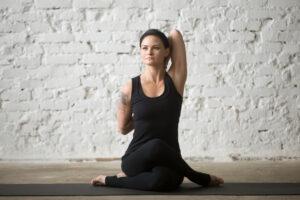When it comes to exercise that promotes health and wellness, yoga consistently ranks as one of the most popular. This is for a good reason. The mind-body intervention (MBI) that yoga initiates has numerous health benefits that stretch beyond mere physical fitness.
Research by the Department of Physiology of the Government Medical College of Nagpur found participants over the age of 40 that practiced yoga for five years had lower pulse rates and blood pressure compared to those who didn’t.
Natalie Nevins, DO, a board-certified osteopathic family physician and certified Kundalini Yoga instructor states that “As an osteopathic physician, I focus a lot of my efforts on preventive medicine and practices, and in the body’s ability to heal itself. Yoga is a great tool for staying healthy because it’s based on similar principles.”
In ‘The Spiritual Benefits of Yoga’, Jane Adamson explains that Yoga is especially helpful for athletes prone to injury and strain as it gives them a way to stay fit and ease back into their active lifestyles without overextending their bodies. This gentle form of exercise is a great practice alongside physiotherapy for injury.
Yoga has been found to relieve anxiety, decrease stress, improve heart health, and reduce chronic pain.
5 Yoga Poses for Injury Recovery
Supta Gomukhasana
Also known as reclined cow face pose. This is one of the best positions to relieve your sciatica—a pain that branches from the lower back, throughout the hips and buttocks. While sciatica typically only affects one side of the body, it can be particularly painful without treatment. Supta Gomukhasana works to gently release tension all throughout the body—especially in your outer hips and gluteal muscles.
Supta Padangustathasana
Are you suffering from tight hamstrings or lower back pain? There are a variety of yoga poses that will help your body these discomforts heal and grow. Among these is Supta Padangustathasana, also known as the reclining hand to big to pose. This pose gently stretches out your lower back muscles and hamstrings and can easily be modified for those recovering from injury. For beginners, you can opt to do this pose with your bottom-leg heel pressed up against the wall, and with a block positioned just outside the hip of your raised leg. The block will help support your thigh, which in turn will help you soften your inner groin, reducing strain on your muscles.
Uttanasana
Knee injuries can be one of the most painful and devastating injuries to an athlete in their prime, and recovery can take a long time. Luckily, patellofemoral pain syndrome (PFPS) can be avoided through keeping your quads supple, hip abductors strong, and maintaining proper strength and length relationships between muscle groups. In addition to hip strengthening, it’s important to add mobility exercises. Standing forward bend pose, as well as childs pose can relieve that stiffness in your spine and hips along the posterior chain.
Sucirandhrasana
Also known as the eye of the needle pose—this yoga pose is a gentler version of pigeon pose. Unlike pigeon, it’s done while lying on your back, which enables you to control the intensity. It stretches the muscles around the lower back, hips, and hamstrings. This pose is particularly beneficial for recovering runners, as their hamstrings can often be tight. Practicing this pose enables better mobility and flexibility, preventing muscle tearing or other injuries from worsening.
Gomukhasana
Also known as cow face pose, this is an excellent practice for athletes looking to strengthen their back muscles as it helps open the back and decrease shoulder stiffness. If you experience tightness in your shoulders or are unable to clasp your hands behind your back, it can be easily modified by holding onto a strap to link your two hands. Gomukhasana relaxes and increases the range of motion in the shoulder joints and hips, which are sites in the body that usually hold tension.
Supplement your Physiotherapy with Yoga for Injury Recovery!
Implementing yoga therapy and yoga practice into your injury recovery regimen is an amazing way to supplement your physiotherapy treatments at Synergy Rehab. If you’re suffering from shoulder pain, a knee injury, muscle pain, or looking for injury prevention—practicing any one of these yoga poses is a good place to start.
Schedule an appointment at your local Synergy Rehab for further assistance with injury recovery. We’ve got your back.












